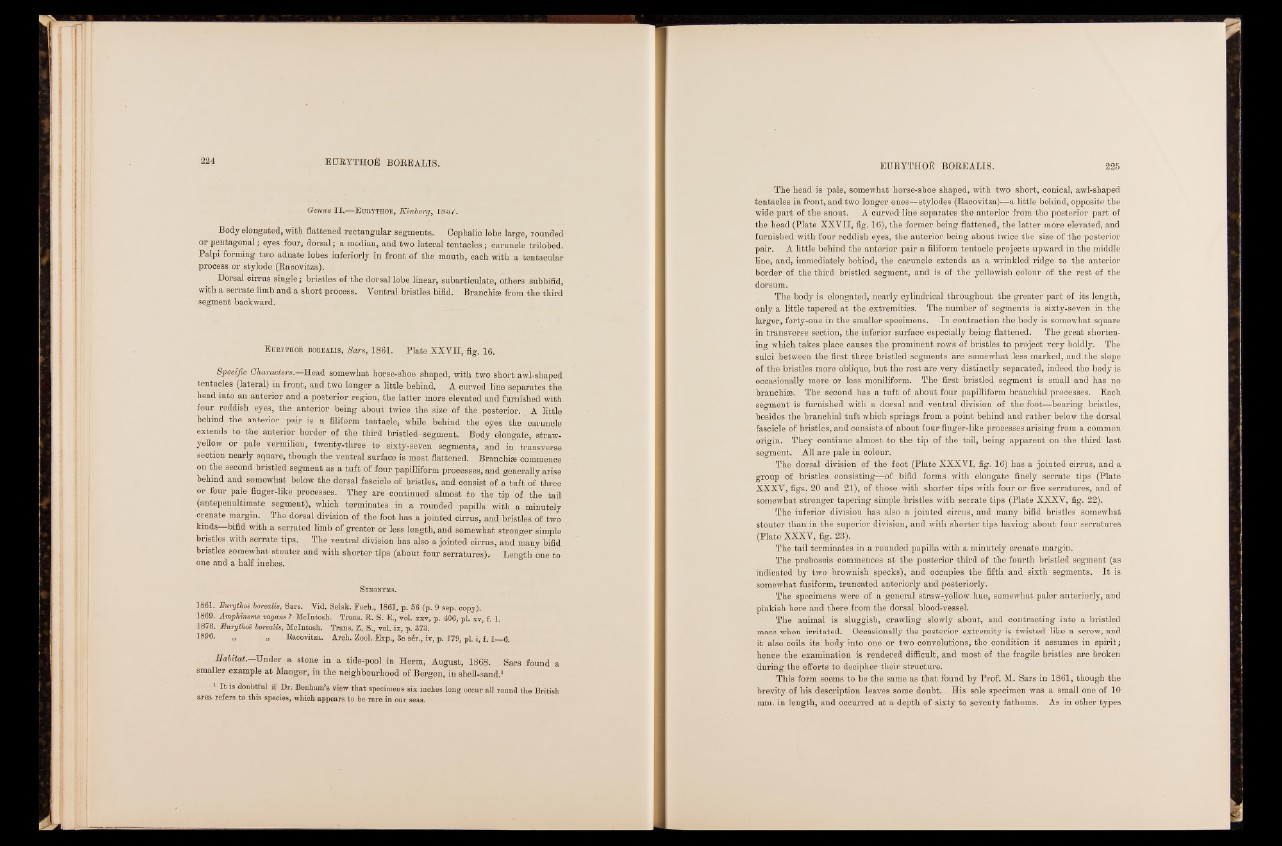
Genus II.—EurtthoS, Emberg, 1857.
Body elongated, with flattened rectangular segments. Cephalic Jobe large, rounded
or pentagonal; eyes .four, dorsal; a median, and two lateral tentacles ; caruncle trilobed..
Palpi forming two adnate lobes interiorly in front of the mouth, each,with a tentacular
process or stylode (Racovitza).
Dorsal cirrus single; bristles of the dorsal lobe linear, subarticulate, others subbifid,
with a serrate limb and a short process. Ventral bristles bifid. Branchiae from the third
segment backward.
Eurythoe borealis, Sars, 1861. Plate XXVII, fig. 16.
Specific Gha/ract&rs.—Head somewhat horse-shoe shaped, with two short awl-shaped
tentacles (lateral) in front, and two longer a little. behind. A curved line separates the
head into an anterior and a posterior region, the latter more elevated and furnished with
four reddish eyes, the anterior being about twice the size of the posterior. A little
behind the anterior pair is a filiform tentacle, while behind the eyes the caruncle
extends to the anterior border of the third bristled-segment. Body elongate, straw-
yellow or pale vermilion, twenty-three to sixty-seven segments, and in transverse
section nearly square, though the ventral surface is most flattened. Branchiae commence
on the second bristled segment as a tuft of four papilliform processes, and generally arise
behind and somewhat below the dorsal fascicle of bristles, and consist of a tuft of three
or four pale finger-like processes. They are continued almost to th S ip /of the tail
(antepenultimate segment), which terminates in a rounded papilla with a minutely
crenate margin. Ihe dorsal division of the foot has a jointed cirrus, and bristles of two
kinds—bifid with a serrated limb of greater or less length, and somewhat stronger simple
bristles with serrate tips. The ventral division has also a jointed cirrus, and many bifid
bristles somewhat stouter and with shorter tips (about four serratures), Length one to
one and a half inches.
S yno nyms.
1861. Eurythoe borealis, Sars. Yid. Selsk. Forh., 1861, p. 56 (p. 9 sep. copy).
1869. Amphmome vagans? McIntosh. Trans. R. S. E.' vol. xxv, p. 406, pi. xv, f. 1.
1876. Eurythoe borealis, McIntosh. Trans. Z. S., vol. ix, p. 373.
1896. „ „ Racovitza. Arch. Zool. Exp., 3e s6r., iv, p. 179, pi. i, f. 1 6. •
• Habitat.—Under a stone in a tide-pool in Herm, August, 1868. Sars found a
smaller example at Manger, in the neighbourhood of Bergen, in shell-sand.1
I t is doubtful if Dr. Benham’s view that specimens six inches long occur all round the British
area refers to this species, which appears to be rare in our seas.
The head is pale, somewhat horse-shoe shaped, with two short, conical, awl-shaped
tentacles in front, and two longer ones—stylodes (Racovitza)—a little behind, opposite the
wide part of the snout. A curved line separates the anterior from the posterior part of
the head (Plate XXVIJ, fig. 16), the former being flattened, the latter more elevated, and
furnished with four reddish eyes, the anterior being about twice the size of the posterior
pair. A little behind the anterior pair a filiform tentacle projects upward in the middle
line, and, immediately behind, the caruncle extends as a wrinkled ridge to the anterior
border of the third bristled segment, and is of the yellowish colour of the rest of the
dorsum.
The body is elongated, nearly cylindrical throughout the greater part of its length,
only a little tapered at the extremities. The number of segments is sixty-seven in the
larger, forty-one in the smaller specimens. In contraction the body is somewhat square
in transverse section, the inferior surface especially being flattened. The great shortening
which takes place causes the prominent rows of bristles to project very boldly. The
sulci between the first three bristled segments are somewhat less marked, and the slope
of the bristles more oblique, but the rest are very distinctly separated, indeed the body is
occasionally more or less moniliform. The first bristled segment is small and has no
branchiae. The second has a tuft of about four papilliform branchial processes. Each
segment is furnished with a dorsal and ventral division of the foot—bearing bristles,
besides the branchial tuft which springs from a point behind and rather below the dorsal
fascicle of bristles, and consists of about four finger-like processes arising from a common
origin. They continue almost to the tip of the tail, being apparent on the third last
segment. All are pale in colour.
The dorsal division of the foot (Plate XXXVI, fig. 16) has a jointed cirrus, and a
group of bristles, consisting—of bifid forms with elongate finely serrate tips (Plate
XXXY, figs. 20 and 21), of those with shorter tips with four or five serratures,' and of
somewhat stronger tapering simple bristles with serrate tips (Plate XXXY, fig. 22).
The inferior division has also a jointed cirrus, and many bifid bristles somewhat
stouter than in the superior division, and with shorter tips having about four serratures
(Plate XXXY, fig. 28). '
The tail terminates in a rounded papilla with a minutely crenate margin.
The proboscis commences at the posterior third of the fourth bristled segment (as
indicated by two brownish specks), and occupies the fifth and sixth segments. I t is
somewhat fusiform, truncated anteriorly and posteriorly.
The specimens were of a general straw-yellow hue, somewhat paler anteriorly, and
pinkish here and there from the dorsal blood-vessel.
The animal is sluggish, crawling slowly about, and contracting into a bristled
mass when irritated. Occasionally the posterior extremity is twisted like a screw, and
it also coils its body into one or two convolutions, the condition it assumes in spirit;
hence the examination is rendered difficult, and most of the fragile bristles are broken
during the efforts to decipher tlieir structure.
This form seems to be the same as that found by Prof. M. Sars in 1861, though the
brevity of his description leaves, some doubt.. His s6le specimen was a small one of 10
ram. in length, and occurred at a depth of sixty to seventy fathoms. As in other types